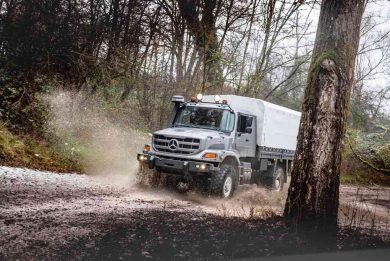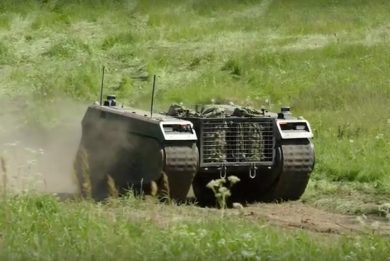IDEX 2025 – RC Direction: Ukrainian UAVs easy to produce
When in February 2022 Russia invaded Ukraine, it was clear that UAVs would have a key role in that conflict, as recent confrontations such as the conflict between Armenia and Azerbaijan over the region of Nagorno-Karabakh had already shown. Confronted with the Russian Army advance, Ukraine had to mobilise not only its troops but also its industry, therefore following the invasion new companies were created to support the war effort, among them RC Direction, which showcased at IDEX part of its production
The initial aim was very clear, to develop highly capable military UAVs, but this was not sufficient as mass production was one of the key issues. Therefore, it developed a hardware that was easy to produce, not only in the mother house, today the company facility covers 1,200 m2, but also in any other facility, the manufacturing system being easily replicated anywhere within two months according to RC Direction, the objective being to allow easy production decentralisation which for a nation at war means resilience.
The company started producing its first systems one year after its foundation, and in 2024 it scaled up its business and started modifying and integrate them following lessons learned from the battlefield.
For RC Direction 2025 marks the launch of its products on the international market, although its production for the time being is mostly if not totally dedicated to the Ukrainian war effort. Hence its presence at the Abu Dhabi exhibition. According to the timeline 2026 will see a further increase in production through decentralisation, while the following years will be marked by advanced research and development initiatives, with the aim to finally increase the company international footprint.
Although the issue of the conflict is all but clear, following recent initiatives by the US President and other players, the increase in production is a must should the confrontation continue; in February 2025 Rustem Umerov, the Ukrainian Minister of Defence, launched the “Drone Line” concept, which aims at creating a 15 km deep area long the frontline constantly monitored by air assets, in which no enemy can move without being seen, and then neutralised, by Ukrainian forces. This means being able to keep an eye 24/7 on the whole area using surveillance drones and possess a sufficient number of suicide drones to take care of the targets. Something to which the RC Direction philosophy seems to answer well.
According to the company presentation many components come from China, which probably means that these are taken from commercial UAVs sold on the free market. Among those we find electronics, servo drives, video data link, and laptop. The propulsion package comes from the USA, while the aircraft structure, control and telemetry systems are produced in Ukraine, the same being true for the catapult and other equipment. Most of the systems acquired on the foreign market are improved by RC Direction, the company also adding AI algorithms to its products in order to increase autonomy to reduce operator’s workload and improve system efficiency.
The Ukrainian company produces a family of UAVs under the name Chaklun, three of which, Chaklun, Chaklun-K and Chaklun 2.0, feature a similar airframe architecture, the same being true for a fourth system, a drone-killer known which however carries a different name, Interceptor. The structure of all those aircraft is made of phenoplasts and phenopolystyrols which, according to RC Direction representatives met at IDEX, gives a series of advantages; the first is to be inexpensive compared to some composite material, the second is that being RF-transparent it reduces the aircraft radar cross-section, decreasing the enemy detection capacity, the third being the easy of production, which is in line with the company delocalisation philosophy.
The aforementioned UAVs have a round-section aerodynamically shaped fuselage with straight mid-wing and V-shaped tailplane, with a vertical stabiliser under the tailplane. They are all electric powered, the motor being located at the rear driving a pushing propeller.
The Chaklun is a reconnaissance UAV, its fuselage being 960 mm long, wingspan being 1,390 mm. Mass at launch is 2.8 ± 0.5 kg and can fly for up to two hours at a cruise speed of 80 km/h, maximum speed being 125 km/h and service ceiling being 3,000 metres. Its datalink allows a range of 75 km, waypoint mode and manual control mode being available. Being a reconnaissance platform that is recovered at the end of the mission, the kit is made of a launching device, a ground control station and two aerial vehicles.
While the Chaklun is a purely reconnaissance system, the Chaklun-K can carry two small free fall ordnance under each wing, the total payload being around 2 kg over the 4.3 kg of maximum take-off mass. With a similar length and wingspan of the Chaklun, its endurance is half of it, which probably means a lighter battery. The Chaklun-K can be provided in the Chaklun-K (A) autonomous version, designed to strike lightly armoured vehicles, communication systems, EW assets, and moving targets, and in the Chaklun-K (M) modernised version, specifically designed to neutralize aerial targets such as reconnaissance drones thanks to the enhanced engine and modified design that allows it to reach a maximum speed of 175 km/h and a maximum operational altitude of 4,000 metres, compared to the 120 km/h and 300 metres of the (A) model. Both versions have a cruise speed of 80 km/h and stall speed of 60 km/h, a ceiling of 4,000 metres, and are equipped with an advanced control and telemetry system, the secure link ensuring a range of up to 30 km even when enemy EW is present. EDR On-Line understands that the Chaklun-K can eventually be sacrificed to neutralise bigger targets, hence the system kit includes the same ground elements and six aircraft, three times those of the Chaklun. According to RC Direction the Chaklun-K flew over 2,000 successful missions against enemy targets.
The Interceptor is a suicidal drone aimed at detonating near the incoming threat to neutralise it. To do so it carries an 800 grams warhead and due to the type of mission flown a kit contains the usual ground support equipment and 10 Interceptor UAVs. These maintain the architecture of the previously described systems, however being heavier it is also bigger, 1,000 mm long with a 1,700 mm wingspan. Its electric motor is powered by a 25 V lithium-ion with a 20,000 mAh capacity, which gives it an endurance between 20 and 60 minutes. The Interceptor is capable to reach a maximum flight speed of 250 km/h, which allows to intercept also high-speed targets, cruising speed being 90 km/h. The model seen at IDEX featured a three-blade propeller; according to the company representative this is due to the much higher speed, probably a recent improvement brochures pictures show a two-blade propeller. The Interceptor is fitted with two wide field-of-view cameras and in the final phase of the attack an automatic target acquisition device leads it close to the target, at a 20-30 metres distance, the very final engagement being done by the pilot bringing the target within lethal distance. The warhead is fitted with a three-step safety device, which allows safe recovery of the UAV if no target is detected and engaged. To be able to intercept high flying targets it can reach a 6,500 metres maximum altitude, operational altitude being between 1,000 and 4,000 metres. RC Direction claims that when used in conjunction with a radar station the Interceptor effectiveness almost doubles. According to the company over 1,000 successful intercepts have been carried out to date.
Although it carries the same Chaklun name of the two UAVs previously describe, the Chaklun-B is a wholly different airframe. Much bigger, its take-off mass is around 45 kg, and it carries a 10-15 kg payload, it has a short fuselage with twin rear boom carrying an inverted-V tailplane. A purely reconnaissance UAV, it is 2,200 mm long with a 3,100 mm wingspan and is powered by an internal combustion engine located at the rear of the fuselage, driving a two-blade propeller. It can fly up to 3,000 metres altitude for six hours at a 130 km/h cruise speed, maximum speed being 155 km/h. Its maximum range is 600 km, distance from the ground control station depending on the datalink installed.
The Chaklun-B 2.0 is a beefed-up version which takes off and land on runways, rather than from a catapult as the previously describes UAV. Length and wingspan are increased respectively to 2,500 and 3,500 mm, take-off mass becomes 65 kg and payload 20-25 kg, with endurance increased to eight hours and range to 900 km. In both cases the mission payload can be tailored to the mission, EW and other packages being added to the typical optronic gimbal. Both the B and the B 2.0 packages contain a single UAV plus support equipment.
More UAVs could be seen on the RC Direction stand as well as in other Ukrainian stands, a demonstration of how the war to counter the Russian invasion is conducted by the Kiev troops. Looking forward at selling to other nations systems that can be definitely defined as “combat proven”.
Photos by P. Valpolini








